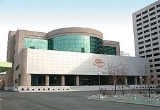
Kim Chaek University of Technology
Encyclopedia
Kim Chaek University of Technology is a university in North Korea
, located on the bank of the Taedong River
in Pyongyang
.
The university is named after General Kim Chaek
.
Kim Chaek University of Technology was originally part of Kim Il Sung University before it was established as the Pyongyang College of Technology (平壤工業大學)” in 1948. In 1951, during the Korean War, the college’s name was changed to “Kim Chaek College of Technology (金策工業大學)” [Note: General Kim Ch’aek, commander of the KPA’s Frontline Headquarters, died in the war.] In 1988, the college was elevated to a university (綜合大學). Between 1981 and 1993, a large-scale construction program doubled the size of the campus to its present size of 400,000m2. The university’s programs in nuclear reactors, nuclear electronics, nuclear fuel and nuclear engineering specialize in training nuclear researchers and technical personnel. Graduates are reportedly posted to the Yŏngbyŏn Nuclear Research Center or to nuclear facilities in Packch’ŏn-kun.
The university has 18 departments (學部) and about 80 programs (學科), about 10,000 students and 2,000 staff. There are 10 research institutes and one graduate school (博士院). There are 54 laboratories and a library with about 600,000 volumes. The campus has a total area of 400,000 square meters.
The Science and Education Department (科學敎育部) under the Korean Workers Party Central Committee (朝鮮勞動黨中央委員會) exercises overall supervision, but the Department of Higher Education (高等敎育部) in the Ministry of Education (敎育省) manages administrative affairs. There are also education bureaus under the people’s committees in every city and/or province (市·都 人民委員會敎育局) that contribute to the formation of education policy, and the local education bureau could provide some input for the school.
North Korea
The Democratic People’s Republic of Korea , , is a country in East Asia, occupying the northern half of the Korean Peninsula. Its capital and largest city is Pyongyang. The Korean Demilitarized Zone serves as the buffer zone between North Korea and South Korea...
, located on the bank of the Taedong River
Taedong River
The Taedong River is a large river in North Korea. It rises in the Rangrim Mountains of the country's north. It then flows southwest into Korea Bay at Namp'o. In between, it runs through the country's capital, Pyongyang. Along the river are landmarks such as the Juche Tower and Kim Il-sung...
in Pyongyang
Pyongyang
Pyongyang is the capital of the Democratic People's Republic of Korea, commonly known as North Korea, and the largest city in the country. Pyongyang is located on the Taedong River and, according to preliminary results from the 2008 population census, has a population of 3,255,388. The city was...
.
The university is named after General Kim Chaek
Kim Chaek
Kim Chaek was a North Korean hero and politician.Born in Sŏngjin, Kim joined the guerrilla war against the Japanese occupation in 1927 and fought alongside Kim Il-sung in Manchuria. He joined the Korean People's Revolutionary Army in 1932. He defected to the Soviet Union to escape the Japanese...
.
Kim Chaek University of Technology was originally part of Kim Il Sung University before it was established as the Pyongyang College of Technology (平壤工業大學)” in 1948. In 1951, during the Korean War, the college’s name was changed to “Kim Chaek College of Technology (金策工業大學)” [Note: General Kim Ch’aek, commander of the KPA’s Frontline Headquarters, died in the war.] In 1988, the college was elevated to a university (綜合大學). Between 1981 and 1993, a large-scale construction program doubled the size of the campus to its present size of 400,000m2. The university’s programs in nuclear reactors, nuclear electronics, nuclear fuel and nuclear engineering specialize in training nuclear researchers and technical personnel. Graduates are reportedly posted to the Yŏngbyŏn Nuclear Research Center or to nuclear facilities in Packch’ŏn-kun.
The university has 18 departments (學部) and about 80 programs (學科), about 10,000 students and 2,000 staff. There are 10 research institutes and one graduate school (博士院). There are 54 laboratories and a library with about 600,000 volumes. The campus has a total area of 400,000 square meters.
The Science and Education Department (科學敎育部) under the Korean Workers Party Central Committee (朝鮮勞動黨中央委員會) exercises overall supervision, but the Department of Higher Education (高等敎育部) in the Ministry of Education (敎育省) manages administrative affairs. There are also education bureaus under the people’s committees in every city and/or province (市·都 人民委員會敎育局) that contribute to the formation of education policy, and the local education bureau could provide some input for the school.

